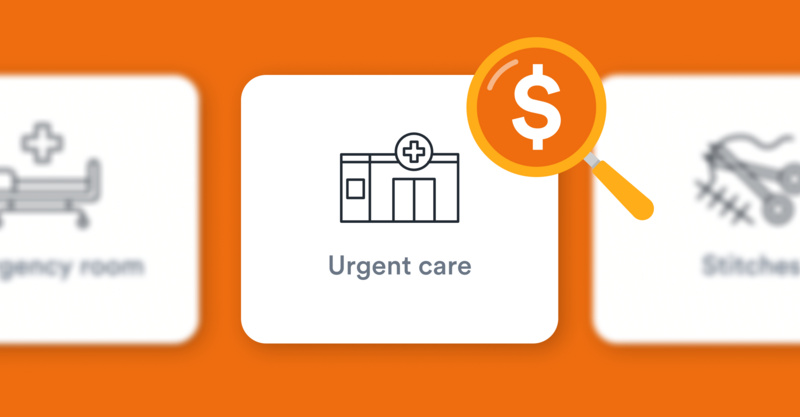

Illness and injuries happen unexpectedly—often causing you to need medical care on short notice. When you’re dealing with a sudden need for medical care, going to urgent care is a great way to avoid the high costs of an emergency room and long wait times for an appointment with your primary care physician.
Before you head out to urgent care, you might be wondering if your insurance will cover your visit. The good news is that most insurance plans do offer coverage for urgent care visits. However, it will depend on your specific plan and the urgent care you visit.
Below you’ll find a comprehensive guide to assist in understanding when your insurance will cover urgent care and how much you can expect in out-of-pocket fees.

Illness and injuries happen unexpectedly—often causing you to need medical care on short notice. When you’re dealing with a sudden need for medical care, going to urgent care is a great way to avoid the high costs of an emergency room and long wait times for an appointment with your primary care physician.
Before you head out to urgent care, you might be wondering if your insurance will cover your visit. The good news is that most insurance plans do offer coverage for urgent care visits. However, it will depend on your specific plan and the urgent care you visit.
Below you’ll find a comprehensive guide to assist in understanding when your insurance will cover urgent care and how much you can expect in out-of-pocket fees.
Urgent care centers provide convenient access to medical services for non-life-threatening health issues that need prompt attention, according to UChicago Medicine. They explain that these facilities are ideal for situations that are not severe enough to require a visit to the emergency room but still require quicker attention than a primary care appointment might offer. With extended hours and no need for an appointment, urgent care centers can be a suitable option for those who are dealing with health issues that arise suddenly or outside of regular office hours.
Common reasons to go to urgent care, according to UChicago Medicine, include:
Urgent care centers bridge the gap between primary care and emergency rooms, offering a middle ground for timely medical care without the long wait times and high costs often associated with hospital ER visits.
According to the Affordable Care Act (ACA), emergency care is one of the required essential health benefits for all long-term health insurance. However, not all insurance companies view urgent care visits as emergency care.
Because insurance providers have specific provider networks, you might find that some urgent care centers are within the network and others are not. Going to a clinic that’s within the insurance plan’s network is a vital way to ensure you get the coverage you need.
Each insurance provider determines if it covers urgent care centers or not. In many cases, insurance providers will cover urgent care, but patients will be expected to pay a co-payment or co-insurance. In some rare cases, an urgent care clinic may not accept your insurance, even if your insurance provider would otherwise pay for the care.
Because of this, it is always best to call ahead and check to see if your urgent care clinic accepts your insurance, and to be aware of your out-of-pocket expenses when it comes to urgent care.
In general, emergency room visits are more expensive than urgent care visits. In fact, an NIH study in Texas showed emergency room costs over $2,000 per visit, while urgent care was only around $165 per visit.
This is because emergency rooms are equipped to handle severe medical emergencies and thus, they have more advanced medical equipment and resources available. As a result, insurance plans may have higher co-pays or deductibles for emergency room visits when compared to urgent care visits.
If you’re traveling, you should check with your insurance provider before you go. They can explain your out-of-state coverage and even help you find providers who are along your route or at your destination that accept your insurance. Don’t forget to also bring your insurance card and prescription card (if you have one) along with you.
When you visit an urgent care clinic, you may be asked to pay your copay upfront. Some urgent care clinics may require you to pay the full price of the visit if you do not have insurance or if they don’t accept your insurance.
According to Debt.org, some urgent care clinics can turn you away if you are unable to pay. Keep in mind that most urgent care clinics accept cash or credit cards. Some clinics may also offer payment plans or financial assistance programs for patients who can't afford to pay their bills in full.
When you arrive at urgent care, you will first check in at the registration desk. Here you will provide your personal information, insurance information, and a brief detail of why you need to get medical care. During this process, you may be asked to pay your copay or the price of your visit if your deductible hasn’t been met yet.
Some urgent care clinics have a triage area. Once you are checked in, a triage nurse will quickly evaluate you and decide how your condition ranks compared to others who need care. For example, if you have a minor illness and someone else has more severe symptoms, they will likely be seen sooner than you.
Either in triage or when you see your provider, you will need to give a more detailed description of your medical history and current symptoms. You will also need to provide a list of medications that you currently take—including any supplements and vitamins.
During your visit, a medical provider will examine you and may order diagnostic testing if needed. Depending on your condition, you may be prescribed medication (such as antibiotics) or you may be referred to a specialist for further treatment. The length of your visit will depend on the severity of your condition and the type of treatment you require.
The cost of visiting an urgent care center with insurance can vary widely based on several factors, including the specifics of the patient's health insurance plan, the services provided during the visit, and the urgent care center's policies.
According to Forbes, patients with insurance will usually pay a copayment, which is a set fee determined by the insurance plan for services like urgent care visits. This copayment can range from $25 to $75 or more, but it's generally lower than the copay for an emergency room visit. Additionally, if you haven’t met your annual deductible, you may be responsible for the full cost of the visit or a larger portion of it until the deductible is met. After the deductible is met, the insurance plan may cover a significant percentage of the costs, with the patient responsible for any coinsurance, which is a percentage of the total bill.
There are some key things to remember when you are going to urgent care as an insured person.
Now all you need to do is find urgent care clinics near you! We can help—start your search with Solv.
Yes, most insurance plans do offer coverage for urgent care visits. However, the coverage will depend on your specific plan and the urgent care you visit.
A premium is the monthly cost of staying enrolled in an insurance plan. A copay is a fixed amount that you pay for a medical service, such as an urgent care visit. A deductible is the amount you pay before your insurance starts covering costs.
Different types of insurance coverage include Health Maintenance Organizations (HMOs), Preferred Provider Organizations (PPOs), Point of Service Plan (POS), Medicare, Medicaid, High Deductible Health Plan (HDHP), and Exclusive Provider Organization (EPO).
Each insurance provider determines if it covers urgent care centers or not. In many cases, insurance providers will cover urgent care, but patients will be expected to pay a co-payment or co-insurance.
No, in general, emergency room visits are more expensive than urgent care visits because emergency rooms are equipped to handle severe medical emergencies and thus, they have more advanced medical equipment and resources available.
Yes, some insurance plans cover services in other states. However, you should check with your insurance provider before you go. They can explain your out-of-state coverage and even help you find providers who are along your route or at your destination that accept your insurance.
If you find yourself going to urgent care without your insurance card, you can check for your insurance information by logging into your online portal through your insurance’s website. If you are unable to find your information through an online portal, you can call your insurance provider and get the information from them over the phone.
Yes, some urgent care clinics can turn you away if you are unable to pay. However, most urgent care clinics accept cash or credit cards. Some clinics may also offer payment plans or financial assistance programs for patients who can't afford to pay their bills in full.

Molly Frank, a seasoned Healthcare Copywriter from Gillette, Wyoming, merges over a decade of healthcare experience with expert business marketing acumen to craft compelling narratives for medical organizations. As a Gillette College alumna, Molly's diverse skill set encompasses copywriting, digital and email marketing, blogging, lead generation, social media and direct mail marketing, advertising, user experience writing, and content marketing.

Dr. Rob Rohatsch leverages his vast experience in ambulatory medicine, on-demand healthcare, and consumerism to spearhead strategic initiatives. With expertise in operations, revenue cycle management, and clinical practices, he also contributes his knowledge to the academic world, having served in the US Air Force and earned an MD from Jefferson Medical College. Presently, he is part of the faculty at the University of Tennessee's Haslam School of Business, teaching in the Executive MBA Program, and holds positions on various boards, including chairing The TJ Lobraico Foundation.
Solv has strict sourcing guidelines and relies on peer-reviewed studies, academic research institutions, and medical associations. We avoid using tertiary references.
Book same-day care for you and your family

When you have a pressing medical issue, your first priority is getting to see a doctor, quickly. Getting an.

Urgent care centers provide quick access to medical attention for non-life-threatening conditions. The.

If you're a Humana member, you may be wondering what kind of coverage your plan provides for urgent care.

The final months of the year can be some of the most stressful for a variety of reasons: gift shopping, family.

To make your visit to urgent care as smooth and efficient as possible, it's important to come prepared with.

The lack of transparency and easily accessible information can sometimes make it feel almost impossible to.

As a parent, you know that unexpected illnesses and injuries can happen at any time—and the cost of urgent.

Urgent care clinics are designed to provide medical treatment for non-life-threatening injuries and.

Melanoma is the most dangerous form of skin cancer—and it's on the rise in younger people. The Melanoma.

If you chose to get a Flexible Spending Account (FSA) as part of your insurance benefits through your.